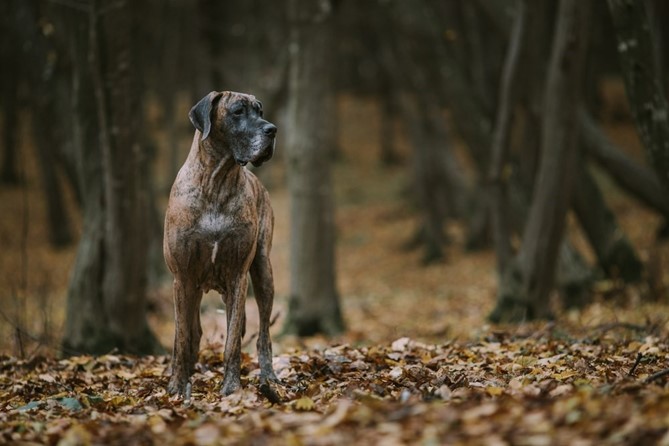A gastric torsion in dogs
It is one of every large dog owner's worst nightmares: gastric torsion. This dangerous condition -also called a stomach twisting or stomach tilt- is very painful for dogs and can even be fatal if not intervened in time. In this blog, we take a closer look at what stomach torsion entails, what the causes are, how to recognize the symptoms and what you can best do to reduce a dog's risk of stomach torsion.

What is a gastric torsion?
In gastric torsion, the stomach rotates on its axis. Because of this rotation, the stomach becomes occluded. This pinches off blood vessels, which in turn causes blood pressure and heart function to be lowered. This means the body does not get enough oxygen.
Because the stomach is closed off, air can no longer escape. This causes the stomach to fill with gas, and this causes the stomach to expand and become increasingly bulging. Breathing and blood circulation are disrupted by the distended stomach, which causes even less oxygen to reach the tissues. The lack of oxygen will damage vital organs and eventually cause the animal to die.
Wat is de oorzaak van een maagtorsie?
The exact cause of gastric torsion is not known. However, several factors have been identified that may increase the likelihood of gastric torsion:
- Dogs of large breeds and dogs with deep chests are more likely to have gastric torsion.
- Genetic predisposition: if a dog's first-degree relative has had a stomach torsion in the past, the likelihood of developing a stomach torsion is greater.
- Dogs that are very active or jump around a lot shortly before or after eating are more likely to develop gastric torsion.
- Dogs with an aggressive or anxious temperament, who therefore also experience more stress, are at greater risk of developing gastric torsion.
- Dogs who have had previous gastrointestinal problems are more likely to have gastric torsion.
- Dogs that are fed a large amount of food once a day are more likely to have gastric torsion than dogs that are fed 3 or 4 times a day.
- Dogs that gobble when eating are at greater risk of developing gastric torsion. This is because when they gobble, a lot of air enters the stomach. This can cause gastric dilatation, which in turn results in a greater risk of developing gastric torsion.
Symptoms of a gastric torsion
It is very important that you recognize a gastric torsion in your dog quickly. You can recognize a dog with gastric torsion by a swollen and hard abdomen (especially on the left side, just behind the ribs). In addition, the dog will try to vomit without anything coming out (empty vomiting), drool a lot and become lethargic. Gastric torsion is very painful for the dog. Pain symptoms such as wheezing or whining, rapid breathing and a cramped posture are therefore also among the symptoms of gastric torsion.
Treatment of a gastric torsion
Gastric torsion is a life-threatening situation and is therefore always an emergency! Therefore, contact your veterinarian immediately if you recognize the symptoms in your dog.
The treatment of a stomach torsion always starts first by stabilizing the dog. This is done by administering oxygen and raising the blood pressure with medication, for example. Next, it is important to take the pressure off the stomach. This is done through a probe into the esophagus or gas is let out of the stomach with a thick needle. In most cases, surgery is required. With this surgery, the stomach is turned back to its normal position and secured to the abdominal wall. This is called gastropexy. This makes the dog less likely to have another stomach torsion. In fact, a dog that has had a gastric torsion once has about an 80% chance of having a gastric torsion again.
How can you prevent a gastric torsion in dogs?
There is much speculation as to whether the form of food (kibble (pressed or extruded), canned food or fresh meat) affects the occurrence of gastric torsion. However, these opinions have not been scientifically proven. Unfortunately, the chances of a dog developing gastric torsion can never be completely prevented. However, there are some things you can consider to reduce the chances of developing stomach torsion:
- Adjust the kibble size of the food to the size of the dog. This will encourage the dog to chew the kibble properly and eat more leisurely.
- Avoid activity 1 hour before and 2 hours after eating. So do not walk the dog after eating or give him his full bowl if he has just come home from a walk.
- Give several small meals a day instead of one or two large meals.
- If the dog is gulping, purchase an anti-smoking bowl so the dog eats more quietly and takes in less air while eating.
In addition to the importance of feeding the dog properly, it is also not recommended to breed with parent dogs that have previously had a stomach torsion. In fact, genetic predisposition is an important indicator of whether or not the dog could develop gastric torsion.
Lots of dogs already enjoy Riverwood every day. Would you also like your dog to feast on our delicious foods and are you curious which variety would suit your dog best? Then answer a few questions here and order an inexpensive sample pack right away.Heel veel honden genieten al elke dag van Riverwood.


